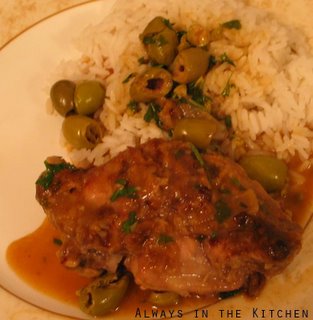
Do you remember that I had the larger part of two rabbits still in the freezer? Well, even well-wrapped, meat doesn't like to be frozen for too long, so we decided to greet the pretend-Spring weather that we've been having with a lovely little dinner of Rabbit in saffron sauce and, not so incidentally, break in my new cookbook Bones by Jennifer McLagan. The recipe was well-written and easily followed, and I did suprisingly little to tweak it to my own cooking reflexes. The technique of blanching the carrots, onions, and asparagus - while not new to me - was something I didn't have a lot of direct experience with. The result was incredibly tender vegetables that weren't at all mushy. I was surprised at how happy I was with the blanched asparagus, since I usually roast them to great effect.
The recipe also delighted me for one particular reason - it contained a mini-dish of seasoned rabbit livers on toasts as an accompaniment. Almost a play-within-a-play, really. I'm not the biggest fan of chicken or beef livers, but the rabbit liver is something special. Petrushka introduced me to rabbit livers pan-fried in butter, seasoned with a restrained hand, and devoured as the cook's treat - a little dish picked up from his chef-friends. I liked it much more than I expected. This dish, I daresay, is actually a little better, as the slight brightness of the parsley actually heightens the delicacy of the liver. Plus, little toasts make an adorable vector.
The saffron, an Iranian variety, was a gift brought back by family visiting the Middle East, and has been waiting patiently on a little throne in my kitchen while I blithered about deciding whether its inaugural use should be risotto alla Milanese, a Moroccan tagine, a paella, an Indian curry, or something else entirely. So, really, this dish was the meeting of several needs: to use the rabbit before it suffered freezer burn, to try a recipe from Bones, and to finally crack open the saffron.
Saffron is a highly distinctive, very unusual flavour, shockingly pungent for such a delicate thread-like spice. There is an almost bitter note that thoroughly permeates anything it comes even remotely in contact with, and contains a particularly strong dye that stains everything it touches (when wet) with a yellow, sometimes orangish hue. It is shockingly expensive - ounce for ounce the most expensive spice in the world. Naturally, it comes in very small containers.
Having broached the packaging, I think that I should probably move forward with some of those other saffron-notorious dishes I was contemplating. It would be a shame for the supply that I have to lose its potency while I vascillate over application. This is ever the challenge of delicacies - one must enjoy them while they are fresh, or risk losing out.















